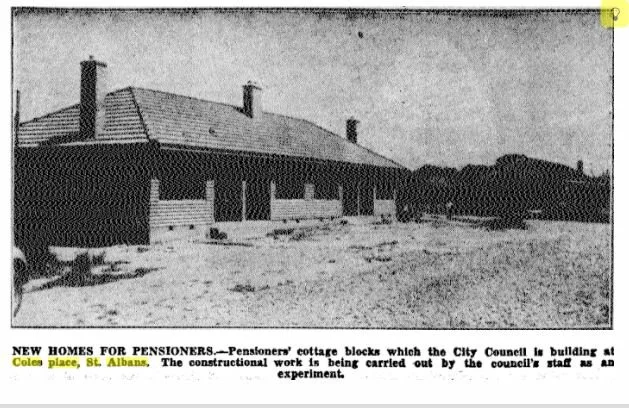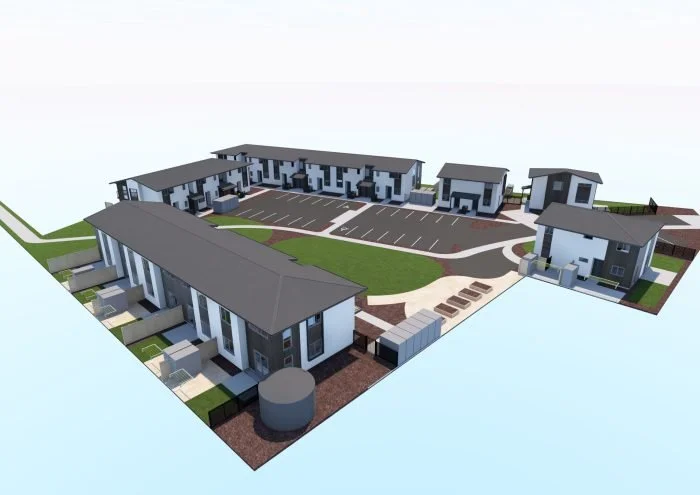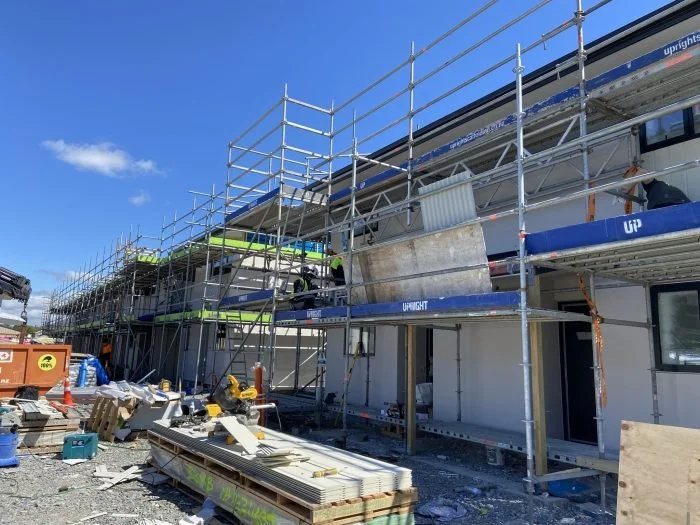Experiment’s lasting legacy
Our newest development started 70 years ago as “an experiment” on tennis club land.
An artist’s impression of ŌCHT’s newest community at Coles Place, St Albans. The development is expected to open in April.
Ōtautahi Community Housing Trust will next month (April) open a new community of 33 new, Homestar 7-rated homes at Coles Place, St Albans.
The warm, dry and energy efficient homes replace 20 weatherboard units built in the 1950s on land previously owned by the St Albans Tennis Club.
The club opened six of the city’s best tennis courts on Springfield Rd in 1930. About 20 years later it offered a plot of excess land to the Christchurch City Council and, as payment, the council shifted its pavilion and paid what it owned on its mortgage.
Coles Place was an “experiment” for the Christchurch City Council’s building department when it was built in the early 1950s, The Press reported. REPORT, PHOTO: The Press, Jan 20, 1953
Mayor Robert Macfarlane’s council resolved to use the land to add homes to the pioneering pensioner housing scheme it started in 1938 (it opened its first units at Barnett Ave in 1939, and at Willard St soon after). In what The Press would later call “an experiment”, the council decided to build the homes itself.
Building department staff started work on a block of four double units and four blocks of six single units in early 1952. The mayor gave the first tenants their keys a year later.
Sound familiar?
The council built the homes to meet an increasing need for pensioner homes in a city whose ageing cohort was growing about as fast as the city population.
Just over 151,000 people lived in Christchurch at the 1945 census. Six years later, the city’s population had ballooned by 15%, to 174,000.
At the same time, the city and the rest of the country struggled with new demand for homes and a construction sector that simply couldn’t keep pace.
Few homes were built during the 1930s depression and the war, so the country was not ready for the post-war economic – and population (and marriage) – boom.
Coles Place several months before demolition.
There was a massive spike in marriages in 1939 and 1940 and reunited couples, and other servicepeople, needed homes when servicepeople came home.
The New Zealand Official Yearbook 1952 tells us cities such as Christchurch experienced acute housing demand that was “far in excess of the available supply”.
This was aggravated by the fact so many already existing homes “did not comply with modern standards of comfort, convenience, and sanitation”.
A skills shortage made matters worse. There was “a persistent lack of sufficient labour” measured by many unsatisfied vacancies at the end of each month, the yearbook notes.
A forlorn weatherboard block awaits its fate as Coles Place is carefully demolished ahead of redevelopment at the end of 2020.
All this prompted another spike, this time in the number of applications for state house rentals. There were 35,866 unsatisfied applications on the books by early 1951.
This was the context in which Christchurch built its own pensioner homes in 1952.
When Coles Place was officially opened, Mayor Macfarlane said every new cottage helped to relieve the general housing shortage in the city.
The development was a great fillip but it hadn’t been easy: it was a difficult site to work on, but progress was further hindered by supply issues.
The new-look Coles Place as rendered before construction work started in 2021.
“Sometimes the timber yards were apparently full of timber, yet we were held up for timber supplies,” Mr Macfarlane said at the opening.
“It gives cause to ponder on what exactly causes these shortages.”
So what’s changed?
Materials and skills shortages were hardly old news when ŌCHT contractor Consortium Construction started work on the new-look Coles Place in 2021.
ŌCHT received the site as part of the Christchurch Housing Accord between the council and the Government, which capitalised the Trust when it was established in 2016.
The ageing homes were demolished in late 2020 and early 2021, well before New Zealand understood how far reaching an impact the global COVID-19 pandemic would have.
Construction began in May 2021 as the pandemic interrupted global supply chains and local access to the many of the materials Consortium would convert into homes.
Materials shortages did not stop the construction team from forging ahead, even-as COVID-19 slowdowns affected build speed.
ŌCHT’s builders worked hard to secure everything from gib board to windows while all trades worked just as hard to secure skilled staff in the pandemic’s tight labour market.
Waves of restrictions, from social distancing to near-lockdown, affected the building programme and could have threatened the April 2022 deadline.
ŌCHT general manager property Ed Leeson says that the keys to the homes will be handed to ŌCHT a month ahead of schedule is testament to the hard work and professionalism of the project team.
“So many outside influences, all of them linked to a pandemic none of us could control, could have affected our plans to open new homes on time.
“But the brilliant relationships that made this project so exciting in the first place kept it on track, even when there were so many challenges.
Floorers and sparkies work on an upstairs home at Coles Place, October 2021.
“We’ve got incredibly valuable, collaborative partnerships with the council, Consortium, project managers Rangzen Projects and those who support them.
“It takes a community to build a community, and the team’s worked hard to deliver it over a sometimes very disruptive year.”
Updating the vision
It’s worth remembering the old pensioner homes were built to house people in need at a time citizens and regulators eschewed homes that “did not comply with modern standards of comfort, convenience, and sanitation”.
They were built to the building codes as they were nearly 70 years ago and, while they were at the leading edge in community housing at the time, over the years they began to fall short of modern expectations.
The homes that replace them update the decades-old idea that community housing can and should help improve the stock of homes available to city residents.
They’ve been designed to achieve the New Zealand Green Building Council’s Homestar 7 rating. That means they’ll be warm and dry and, in many areas, will exceed the New Zealand building code.
Modern materials, passive solar design and high-spec insulation will help make them homes that are environmentally sound and cheaper to run.
They’ll be home to a range of tenants, from single people to families. Five of the homes have two or more bedrooms, reflecting the current and forecast growth in the need for family homes in our fast-growing city.
The homes have private courtyards and share communal spaces that feature a communal vegetable garden, fruit trees and grassed gathering spaces. There’ll be plenty of space for people to meet, and children to play.
The development recognises the importance of creating a living environment that builds a sense of pride, enhances wellbeing and helps people connect. The kaupapa, or cultural principal that underpins this is whanaungatanga, close connection between people.
ŌCHT chief executive Cate Kearney says Coles Place is a modern, future-proofed response to the ongoing need to help people in need into a home.
“Community housing is needed more now than ever, and in all suburbs, especially as we see the impact of the housing shortage, high rentals and the effects of COVID-19 on the number of people in need of a home.
“More and more people need a home, and they want the chance to sustain their tenancies, to have the security that comes with having a home and being part of a community.
“ŌCHT is committed to helping people achieve sustainable tenancies, and to providing warm, dry, safe and modern homes.
“Coles Place has been part of Christchurch’s community housing story for nearly 70 years, and the new community will continue making a positive contribution to our city for decades to come.”
The new homes further demonstrate the Trust’s design and construction capability, and the standards achieved by its project partners.
They are also a tangible demonstration of what can be achieved when the Trust, the council and the government work together.
“ŌCHT is proud to be part of a community housing sector that’s working with the government to provide more, better homes for those most in need of housing,” Cate says.
This is the 11th community of new homes ŌCHT has delivered since its inception. ŌCHT’s delivered 229 new homes since 2019; 213 of them since 2020.
Coles Place vital stats
This is the 11th community of new homes ŌCHT has delivered since its inception.
ŌCHT’s delivered 229 new homes since 2017 – 213 of them since 2020.
The new-look Coles Place replaces 20 units built by the city council in 1952 and opened in 1953.
Coles Place transferred to ŌCHT as part of the 2014 Christchurch Housing Accord.
The homes largely survived the quakes but were old and cold, and well past their use-by date.
Tenants were rehoused in late 2020. Demolition happened December 2020-January 2021.
Contractor Consortium Construction started building in May 2021.
Rangzen Projects was project manager.
The development comprises 1 x 4 bed, 1 x 3 bed, 3 x 2 bed, 28 x 1 bed homes. That’s 37 bedrooms over 33 homes.
They’re in six two-storey blocks.
It’s got a gross floor area of 2053m2.
It’s built on a 5213m2 site.








